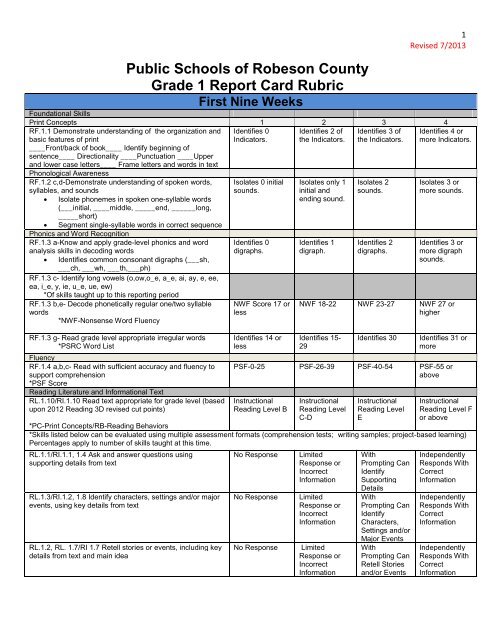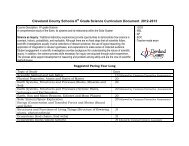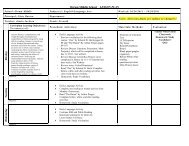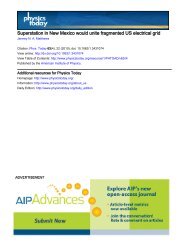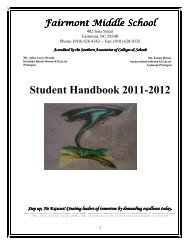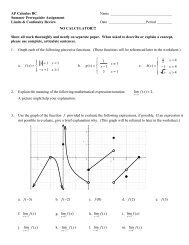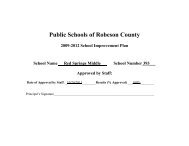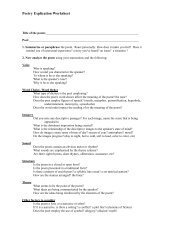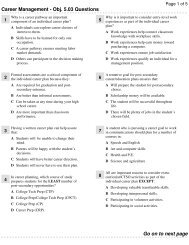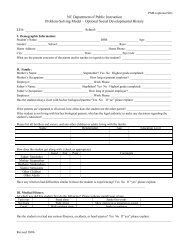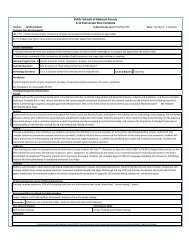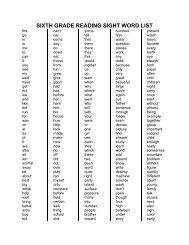Public Schools of Robeson County Grade 1 Report Card Rubric
Public Schools of Robeson County Grade 1 Report Card Rubric
Public Schools of Robeson County Grade 1 Report Card Rubric
- No tags were found...
Create successful ePaper yourself
Turn your PDF publications into a flip-book with our unique Google optimized e-Paper software.
3Revised 7/2013Number and Operations in Base Ten1.NBT.1 Count, read, and write numbers to 120 andrepresent a number <strong>of</strong> objects with a numeral. (30) first, (50)second, (75) third, (120) fourthCounts, Readsand Writes14 orLessCounts, Readsand Writes 15-29SentenceCounts, Readsand Writes to30Counts, Readsand Writes 31and Above1.NBT.2 Understand the place value <strong>of</strong> a two-digit numberas tens and ones1.NBT.3 Compare two two-digit numbers using symbols(,=)1.NBT.4, 1.NBT.5 Add within 100 using a two digit and aone-digit number, identify 10 more10 less.1.NBT.6 Subtract multiples <strong>of</strong> 10 from 10-90Measurement and Data1.MD.1, 1.MD.2 Compare the lengths <strong>of</strong> three objects andexpress the length as a whole number <strong>of</strong> length units1.MD.3 Tell and write time in hours and half-hours usingdigital and analog clocks1.MD.4 Organize, represent, and interpret data in up to threecategories and compare the data (how many more/less ineach group)Geometry1.G.1 Distinguish between defining attributes and nondefiningattributes; build and draw shapes to show definingattributes Triangle/Square/Rectangle/Circle/Hexagon/Trapezoid/Parallelogram1.G.2 Compose two or three-dimensional shapes to create acomposite shape and compose new shapes from thecomposite shape1.G.3 Partition circles and rectangles into two and four equalshares and describe using halves, fourths, and quartersIdentifies TensOR OnesStudents CannotOrganize,Represent andInterpret DataStudents CannotDistinguishBetweenDefining andNon-DefiningAttributesIdentifies TensAND OnesStudentsInconsistentlyOrganize,Represent andInterpret DataStudentsInconsistentlyDistinguishBetweenDefining andNon-DefiningAttributesIdentifiesUsingManipulativesStudents NeedMinimalSupportOrganizing,RepresentingandInterpretingDataWithPromptingStudentsDistinguishBetweenDefining andNon-DefiningAttributesIdentifies orProduces UsingManipulativesStudentsIndependentlyOrganize,Represent andInterpret DataStudentsIndependentlyDistinguishBetweenDefining andNon-DefiningAttributesScienceDemonstrates an understanding <strong>of</strong> scientific conceptsappropriate to grade levelSocial StudiesDemonstrate an understanding <strong>of</strong> community, diversecultures and geographyNo responseNo responseAsks limitedquestions andprovidesinaccurateinformationHas limited <strong>of</strong>key socialstudiesconceptsWith promptingasksquestions,makepredictions andcommunicateobservations.Communicatesandunderstandskey socialstudiesconcepts withprompting andsupportWithoutprompting asksquestions, makepredictions andcommunicateobservationsCommunicatesandunderstandskey socialstudiesconceptswithoutprompting andsupport
Second Nine Weeks4Revised 7/2013Foundational SkillsPrint Concepts 1 2 3 4RF.1.1 Demonstrate understanding <strong>of</strong> the organization andbasic features <strong>of</strong> print____Front/back <strong>of</strong> book ____Identify beginning <strong>of</strong> sentence____Directionality ____Punctuation ____Upper and lowercase letters ____Frame letters and words in textIdentifies 1 <strong>of</strong> theindicators.Identifies 3 <strong>of</strong>the indicators.Identifies 4 <strong>of</strong>the indicators.Phonological AwarenessRF.1.2 c,d-Demonstrate understanding <strong>of</strong> spoken words,syllables, and soundsIsolate phonemes in spoken one-syllable words(___initial, ____middle, _____end, ______long,_____short) Segment single-syllable words in correct sequencePhonics and Word RecognitionRF.1.3 a-Know and apply grade-level phonics and wordanalysis skills in decoding words Identifies common consonant digraphs (___sh,___ch, ___wh, ___th,___ph)RF.1.3 c- Identify long vowels (o,ow,o_e, a_e, ai, ay, e, ee,ea, i_e, y, ie, u_e, ue, ew)*Of skills taught up to this reporting periodRF.1.3 b,e- Decode phonetically regular one/two syllablewords* Non-Sense Word FluencyDemonstratesunderstanding <strong>of</strong>1 <strong>of</strong> theindicators.Identifies 1digraph.Identifies 0 longvowel soundpatterns.Demonstratesunderstanding<strong>of</strong> 2 <strong>of</strong> theindicators.Identifies 2digraphs.Identifies 1-2long vowelsoundpatterns.Demonstratesunderstanding<strong>of</strong> 3 <strong>of</strong> theindicators.Identifies 3digraphs.Identifies 3-4long vowelsound patterns.Identifies 6 <strong>of</strong> theindicators.Demonstratesunderstanding <strong>of</strong> 4or more <strong>of</strong> theindicators.Identifies 4 ormore digraphs.Identifies 5 ormore long vowelsound patterns.RF.1.3 g-Read grade level appropriate irregular words* PSRC Word ListFluencyRF.1.4 a,b,c- Read with sufficient accuracy and fluency tosupport comprehension*DORF Fluency/ Accuracy ScoreReading Literature and Informational TextRL.1.10/RI 1.10 Read text appropriate for grade level(based upon 2012 Reading 3 D REVISED cut points)*PC- Print Concepts/RB- Reading BehaviorsIdentifies 29 orbelow HFWDORF Fluency 0-16/Accuracy 0-68InstructionalReading Level C-DIdentifies 30-59 HFWDORF Fluency16-23/Accuracy 68-78InstructionalReading LevelEIdentifies 60 orless HFWDORF Fluency23-30/ Accuracy78-88InstructionalReading Level FIdentifies 61 ormore HFWDORF Fluency 31or above/Accuracy 89 oraboveInstructionalReading Level Gor above*Skills listed below can be evaluated using multiple assessment formats (comprehension tests;writing samples; project-based learning)PercentagesRL.1.1, 1.4/RI 1.1 Ask and answer questions usingsupporting details from textRL.1.3/RI 1.2, 1.8 Identify characters, settings and/or majorevents, using key details from textLimited responseor providesincorrectinformationLimited responseor cannot namecharacters orsettingWith promptingcan identifysupportingdetailsWith promptingcan namecharacters andsettingIndependentlyresponds withcorrectinformationIndependentlynamescharacters,setting, andmajor eventscorrectlyConsistentlyrespondsindependently withaccurate detailsfrom textConsistentlyrespondsindependentlynamingcharacters,setting, and majorevents
5Revised 7/2013RL 1.2, 1.7/RI.1.7 Retell stories or events, including keydetails from text and main ideaLimited responseor incorrectdetails whenretelling storiesWith promptingcan retell storiesusing somedetailsIndependentlyretells storiesusing keydetails andincludes mainideaConsistentlyretells stories orevents using keydetails/ main ideawith elaborationRL.1.5/RI.1.3, 1.6 Identify connections between events,ideas or informationRI.1.5 Know and use various text features Title, Author/Illustrator, Table <strong>of</strong> Contents,Illustrations/Photographs, Page Numbers,Captions, Print (Bold/Color/Italics)RL.1.9/RI.1.9 Compare and contrast texts on the same topicLimited responseor unable tomakeconnectionsKnows and uses2 or lessindicatorsCannot identify asimilarity or adifferenceWith promptingcan makeconnectionsbetween eventsKnows anduses 3indicatorsCan identify asimilarity or adifferenceIndependentlymakesconnectionsbetweenevents, ideas,or informationKnows anduses 4indicatorsCan identify asimilarity and adifferenceConsistentlyrespondsindependently bymakingconnectionsbetween events,ideas, orinformationKnows and uses 5or more indicatorsCan identify morethan one similarityand differenceWriting/LanguageW.1.1, 1.2, 1.3 Write in different genresWrites somesimple sentenceswith somephonemicspelling in onegenreWrites severalsimplesentences ontopic with abeginning,middle and endin one genreWrites a storywith abeginning,middle, and,end in 2 ormore genresWrites stories witha beginning,middle, and endon topic innarrative, opinion,and informationtextsW.1.5, 1.6 Produce and publish writing using a variety <strong>of</strong>digital toolsW.1.7 Participate in shared research and writing projectsParticipates withsignificantsupportParticipates withlittle supportParticipateswith somesupportParticipates withminimal supportL.1./L.1.2 a,b,c- Apply appropriate mechanics in writing <strong>of</strong>texts Capitalization, Period, Question mark, ExclamationMark, Quotation marks/CommasL.1.1 b,c,d,e,f,g,h,I,j/L.1.2 d- Use conventions <strong>of</strong> standardEnglish grammar in speaking and writing Parts <strong>of</strong> speech, Subject/verb agreement,Inflectional endings, Verb tense, Word choiceRL.1.4/L.1.4, 1.5, 1.6 Identify multiple-meaning wordsRF.1.3/L.1.2 e- Apply grade-level phonics and word analysisskills PSRC Word listsOperations and Algebraic ThinkingRepresent and Solve Problems (addition/subtraction)1.OA.1, 1.OA.2 Use addition and subtraction within 20 tosolve word problems (using objects, drawings, andUses 1 or lessindicatorsUses 1 or lessindicatorsStudentsdemonstrateminimalunderstanding <strong>of</strong>wordrelationships.29 words orbelowStudents modeladd/sub. UsingUses 2indicatorsUses 2indicatorsWith promptingstudentsdemonstratesomeunderstanding<strong>of</strong> wordrelationships.Uses 3indicatorsUses 3indicatorsStudentsconsistentlydemonstrateunderstanding<strong>of</strong> wordrelationships.Uses 4 or moreindicatorsUses 4 or moreindicatorsStudentsindependently andconsistentlydemonstrateunderstanding <strong>of</strong>wordrelationships.30-59 words 60-75 words 76 words or moreStudentsconsistentlyStudents useobjects andStudents modeladd./sub. with
equations) objects model add./sub.Using objectsdrawings tomodeladd./sub. To206Revised 7/2013objects, drawings,and equations1.OA.3, 1.OA.4 Apply properties <strong>of</strong> operations to add andsubtract (commutative, associative)1.OA.5, 1.OA.6, 1.OA.8 Demonstrate fluency for additionand subtraction (relate fact families that are equal 8+1=9, 9-8=1)Students cannotidentify oneproperty beingused to add orsubtractStudents cannotdemonstratefluency inadd/sub to 10Students canidentify oneproperty beingused to add orsubtractStudentsdemonstratefluency inadd/sub to 10with significantsupportStudentsidentify twoproperties <strong>of</strong>operationswhen addingandsubtractingWith minimalsupportStudentsdemonstratefluency inadd/sub to 10with minimalsupportStudents identifytwo properties <strong>of</strong>operations whenadd/subindependentlyStudentsdemonstratefluency in add/subto 10independently1.0A.7 Understand the meaning <strong>of</strong> equal signs anddetermine if addition/subtraction sentences are trueStudents identifythe equal sign inan add/subsentenceStudentsidentify andexplain theequal signStudents canidentify equalgroupsStudents canmodel equalgroups sentenceswith objects andpicturesNumber and Operations in Base Ten1.NBT.1 Count, read, and write numbers to 120 andrepresent a number <strong>of</strong> objects with a numeral. (30) first, (50)second, (75) third, (120) fourth1.NBT.2 Understand the place value <strong>of</strong> a two-digit numberas tens and ones1.NBT.3 Compare two two-digit numbers using symbols(,=)1.OA.4, 1.OA.5 Add within 100 using a two digit and a onedigitnumber, identify 10 more10 less.24 and below 25-49 0-50 51 or aboveIdentifytens/ones in anumberIdentify onecomparisonsymbol usingmanipulativesCannot add 2-digit and 1 digitnumbers, andcannot identify10 more or 10less.Decompose bytens/ones usingmanipuativesIdentify twocomparisonsymbols usingmanipulativesNeedssignificantassistancewhen adding a2-digit and a 1digit number, orwhen identifying10 more or 10less.Identify andmodel tensand ones innumbers usingmanipulativesIdentify threecomparisonsymbols usingmanipulativesCan add a 2-digit and a 1-digit numberwith minimalsupport, canidentify 10more or 10less withminimalsupportIdentify andproduce numbersby tens/onesusingmanipulatives andpictorialrepresentationsIdentify threecomparisonsymbols usingpictorialrepresentationCan fluently add a2-digit and a 1digit number, ANDfluently identify 10more or 10 less1.OA.6 Subtract multiples <strong>of</strong> 10 from 10-90Measurement and Data1.MD.1, 1.MD.2 Compare the lengths <strong>of</strong> three objects andexpress the length as a whole number <strong>of</strong> length unitsCannot subtractmultiples <strong>of</strong> 10from 10-90Identify smallestor longest;Inconsistentlysubtractsmultiples <strong>of</strong> 10from 10-90Order twoobjects byConsistentlysubtractsmultiples <strong>of</strong> 10from 10-90Order threeobjects byFluently subtractsmultiples <strong>of</strong> 10from 10-90Students measurethree objects by
7Revised 7/20131.MD.3 Tell and write time in hours and half-hours usingdigital and analog clocks1.MD.4 Organize, represent, and interpret data in up to threecategories and compare the data (how many more/less ineach group)Geometry1.G.1 Distinguish between defining attributes and nondefiningattributes; build and draw shapes to show definingattributes Triangle/Square/Rectangle/Circle/Hexagon/Trapezoid/Parallelogram1.G.2 Compose two or three-dimensional shapes to create acomposite shape and compose new shapes from thecomposite shape1.G.3 Partition circles and rectangles into two and four equalshares and describe using halves, fourths, and quartersidentify shortestor tallestStudents cannotidentify parts <strong>of</strong> aclock (analog ordigital)Studentsinconsistentlyorganize,represent, andinterpret dataInconsistentlydistinguishesbetween definingand non-definingattributessmallest tolongest orshortest totallestStudentsinconsistentlyidentify parts <strong>of</strong>a clock (analogand digital)Students needminimal supportto organize,represent, andinterpret dataWith prompting,consistentlydistinguishesbetweendefining andnon-definingattributessmallest tolongest orshortest totallestStudentsidentify parts <strong>of</strong>a clock (analogand digital)and nameseconds in aminute,minutes in anhour, andhours in a dayStudentsconsistentlyorganize,represent, andinterpret dataIndependentlydistinguishesbetweendefining andnon-definingattributesinches andcompare thelengths byordering inmultiple waysStudents tell timeto the hour onanalog and digitalclocksStudentsindependently andconsistentlyorganize,represent, andinterpret dataIndependentlydistinguishesbetween definingand non-definingattributes andbuilds/drawsshapes to showdefining attributesScienceDemonstrates an understanding <strong>of</strong> scientific conceptsappropriate to grade levelSocial StudiesDemonstrate an understanding <strong>of</strong> community, diversecultures and geographyNo responseNo responseAsks limitedquestions andprovidesinaccurateinformationHas limited <strong>of</strong>key socialstudiesconceptsWith promptingand supportasksquestions,makepredictions andcommunicateobservations.Communicatesandunderstandskey socialstudiesconcepts withprompting andsupportWithout promptingand support asksquestions, makepredictions andcommunicateobservationsCommunicatesand understandskey social studiesconcepts withoutprompting andsupport
Third Nine Weeks8Revised 7/2013Foundational SkillsPrint Concepts 1 2 3 4RF.1.1 Demonstrate understanding <strong>of</strong> the organization andbasic features <strong>of</strong> print____Front/back <strong>of</strong> book ____Identify beginning <strong>of</strong> sentence____Directionality ____Punctuation ____Upper and lowercase letters ____Frame letters and words in textIdentifies 2 <strong>of</strong> theindicators.Identifies 4 <strong>of</strong>the indicators.Identifies 5 <strong>of</strong>the indicators.Phonological AwarenessRF.1.2 c,d- Demonstrate understanding <strong>of</strong> spoken words,syllables, and soundsIsolate phonemes in spoken one-syllable words(___initial, ____middle, _____end, ______long,_____short) Segment single-syllable words in correct sequencePhonics and Word RecognitionRF.1.3 a- Know and apply grade-level phonics and wordanalysis skills in decoding words Identifies common consonant digraphs (___sh,___ch, ___wh, ___th,___ph)RF.1.3 c- Identify long vowels (o,ow,o_e, a_e, ai, ay, e, ee,ea, i_e, y, ie, u_e, ue, ew)*Of skills taught up to this reporting periodRF.1.3 b,e- Decode phonetically regular one/two syllablewords* Non-Sense Word FluencyRF.1.3 g- Read grade level appropriate irregular words* PSRC Word ListFluencyRF.1.4 Read with sufficient accuracy and fluency to supportcomprehension*Progress MonitoringReading Literature and Informational TextRL.1.10/RI 1.10 Read text appropriate for grade level(based upon 2012 Reading 3 D REVISED cut points)*PC- Print Concepts/RB- Reading BehaviorsDemonstratesunderstanding <strong>of</strong>2 <strong>of</strong> theindicators.Identifies 2digraphs.Identifies 1-3long vowel soundpatterns.Demonstratesunderstanding<strong>of</strong> 3 <strong>of</strong> theindicators.Identifies 3digraphs.Identifies 4-6long vowelsoundpatterns.Demonstratesunderstanding<strong>of</strong> 4 <strong>of</strong> theindicators.Identifies 4digraphs.Identifies 7-9long vowelsound patterns.Identifies 6 <strong>of</strong> theindicators.Demonstratesunderstanding <strong>of</strong> 5or more <strong>of</strong> theindicators.Identifies all 5digraphs.Identifies10 ormore long vowelsound patterns.NWF 32 or below NWF 33-38 NWF 39-43 NWF 44 or aboveIdentifies 44 orbelow HFWPM- Far BelowPr<strong>of</strong>icientInstructionalReading Level EIdentifies 45-89 HFWPM-BelowPr<strong>of</strong>icientInstructionalReading LevelFIdentifies 90HFWPM-Pr<strong>of</strong>icientInstructionalReading LevelG-HIdentifies 91 ormore HFWPM-AdvancedInstructionalReading Level I orabove*Skills listed below can be evaluated using multiple assessment formats (comprehension tests;writing samples; project-based learning)Percentages apply to number <strong>of</strong> skills taught at this timeRL.1.1/RI 1.1, 1.4 Ask and answer questions usingsupporting details from textRL.1.3/RI.1.2,1.8 Identify characters, settings and/or majorevents, using key details from textWith promptingcan identifysupportingdetailsWith promptingcan namecharacters andsettingIndependentlyresponds withcorrectinformationIndependentlynamescharacters,setting, andmajor eventscorrectlyConsistentlyrespondsindependentlywith accuratedetails fromtextConsistentlyrespondsindependentlynamingcharacters,setting, andmajor eventsConsistentlyrespondsindependently withaccurate detailsfrom text andelaborates ondetailsConsistentlyrespondsindependentlynamingcharacters,setting, and majorevents using keydetails from textwith broadelaboration
9Revised 7/2013RL.1.2, 1.7/RI 1.7 Retell stories or events, including keydetails from text and main ideaRL.1.5/RI.1.3, 1.6 Identify connections between events,ideas or informationWith promptingcan retell storiesusing somedetailsWith promptingcan makeconnectionsbetween eventsIndependentlyretells storiesusing keydetails andincludes mainideaIndependentlymakesconnectionsbetween events,ideas, orinformationConsistentlyretells storiesor events usingkey details/main ideaConsistentlyrespondsindependentlyby makingconnectionsbetweenevents, ideas,or informationConsistentlyretells stories orevents using keydetails/ main ideawith elaborationConsistentlyrespondsindependently bymakingconnectionsbetween events,ideas, orinformation withbroad elaborationRI.1.5 Know and use various text features Title, Author/Illustrator, Table <strong>of</strong> Contents,Illustrations/Photographs, Page Numbers,Captions, Print (Bold/Color/Italics)Knows and uses3 or lessindicatorsKnows anduses 4indicatorsKnows anduses 5indicatorsKnows and uses 6or more indicatorsRL.1.9/RI.1.9 Compare and contrast texts on the same topicCan identify asimilarity or adifferenceCan identify asimilarity and adifferenceCan identify 2similarities and2 differencesCan identify morethan 2 similaritiesand 2 differencesWriting/LanguageW.1.1, 1.2, 1.3 Write in different genresW.1.5, 1.6 Produce and publish writing using a variety <strong>of</strong>digital toolsW.1.7 Participate in shared research and writing projectsL.1.1, 1.2 a,b,c- Apply appropriate mechanics in writing <strong>of</strong>texts Capitalization, Period, Question mark, Exclamationmark, Quotation marks/CommasL.1.1 b,c,d,e,f,g,h,I,j, L.2 d- Use conventions <strong>of</strong> standardEnglish grammar in speaking and writing Parts <strong>of</strong> speech, Subject/verb agreement,Inflectional endings, Verb tense, Word choiceRL.1.4/L.1.4, 1.5, 1.6- Identify multiple-meaning wordsWrites severalsimple sentenceson topic with abeginning,middle and endin one genreProduces 1product withsignificantsupportParticipates withlittle supportUses 2 or lessindicatorsUses 2 or lessindicatorsWith promptingstudentsdemonstratesomeunderstanding <strong>of</strong>wordrelationships.Writes a storywith abeginning,middle, and,end in 2 or moregenresProduces 1product withsome supportParticipates withsome supportUses 3indicatorsUses 3indicatorsStudentsconsistentlydemonstrateunderstanding<strong>of</strong> wordrelationships.Writes storieswith abeginning,middle, andend on topic innarrative,opinion, andinformationtextsProduces 1product withminimalsupportParticipateswith minimalsupportUses 4indicatorsUses 4indicatorsStudentsindependentlyandconsistentlydemonstrateunderstanding<strong>of</strong> wordrelationships.Writes stories witha beginning,middle, and endon topic innarrative, opinion,and informationtexts withelaborationProduces 1productindependentlyParticipatesindependentlyUses 5 or moreindicatorsUses 5 or moreindicatorsStudentsindependently andconsistentlydemonstrateunderstanding <strong>of</strong>word relationshipsabove grade level
RF.1.3/L.1.2 e-Apply grade-level phonics and word analysisskills PSRC Word listsOperations and Algebraic ThinkingRepresent and Solve Problems (addition/subtraction)1.OA.1, 1.OA.2 Use addition and subtraction within 20 tosolve word problems (using objects, drawings, andequations)1.OA.3, 1.OA.4 Apply properties <strong>of</strong> operations to add andsubtract (commutative, associative)1.OA.5, 1.OA.6, 1.OA.8 Demonstrate fluency for additionand subtraction (relate fact families that are equal 8+1=9, 9-8=1)44 words orbelowStudentsconsistentlymodel add./sub.Using objectsStudents canidentify oneproperty beingused to add orsubtractStudentsdemonstratefluency inadd/sub to 10with significantsupport10Revised 7/201345-89 words 90 words 91 words or moreStudents useobjects anddrawings tomodel add./sub.To 20Studentsidentify twoproperties <strong>of</strong>operationswhen addingand subtractingWith minimalsupportStudentsdemonstratefluency inadd/sub to 10with minimalsupportStudentsmodeladd./sub. withobjects,drawings, andequationsStudentsidentify twoproperties <strong>of</strong>operationswhen add/subindependentlyStudentsdemonstratefluency inadd/sub to 10independentlyStudents modeladd./sub. withequations andmental strategiesStudents identifytwo properties <strong>of</strong>operations whenadd/subindependently andconsistentlyStudentsdemonstratefluency in add/subto 10independently andconsistently1.OA.7 Understand the meaning <strong>of</strong> equal signs anddetermine if addition/subtraction sentences are trueNumber and Operations in Base Ten1.NBT.1 Count, read, and write numbers to 120 andrepresent a number <strong>of</strong> objects with a numeral. (30) first, (50)second, (75) third, (120) fourth1.NBT.2 Understand the place value <strong>of</strong> a two-digit numberas tens and ones1.NBT.3 Compare two two-digit numbers using symbols(,=)1.NBT.4, 1.NBT.5 Add within 100 using a two digit and aone-digit number, identify 10 more10 less.1.NBT.6 Subtract multiples <strong>of</strong> 10 from 10-90Students identifyand explain theequal signStudents canidentify equalgroupsStudents canmodel equalgroups/sentences withobjects andpicturesStudents canmodel equalgroups/equationsand determine ifthey are true orfalse37 and below 38-74 0-75 76 or aboveDecompose bytens/ones usingmanipuativesIdentify twocomparisonsymbol usingmanipulativesNeeds significantassistance whenadding a 2-digitand a 1 digitnumber, or whenidentifying 10more or 10 less.InconsistentlysubtractsIdentify andmodel tens andones innumbers usingmanipulativesIdentify threecomparisonsymbols usingmanipulativesCan add a 2-digit and a 1-digit numberwith minimalsupport, canidentify 10 moreor 10 less withminimal supportConsistentlysubtractsIdentify andproducenumbers bytens/onesusingmanipulativesand pictorialrepresentationIdentify threecomparisonsymbols usingpictorialrepresentationCan fluentlyadd a 2-digitand a 1 digitnumber, ANDfluently identify10 more or 10less withminimalsupportFluentlysubtractsIdentify andproduce two digitnumbers mentallyIdentify threecomparisonsymbols inequationsCan fluently andindependently adda 2-digit and a 1digit number, ANDfluently identify 10more or 10 lessIndependently andfluently subtracts
11Revised 7/2013Measurement and Data1.MD.1, 1.MD.2 Compare the lengths <strong>of</strong> three objects andexpress the length as a whole number <strong>of</strong> length units1.MD.3 Tell and write time in hours and half-hours usingdigital and analog clocks1.MD.4 Organize, represent, and interpret data in up to threecategories and compare the data (how many more/less ineach group)Geometry1.G.1 Distinguish between defining attributes and nondefiningattributes; build and draw shapes to show definingattributes Triangle/Square/Rectangle/Circle/Hexagon/Trapezoid/Parallelogram1.G.2 Compose two or three-dimensional shapes to create acomposite shape and compose new shapes from thecomposite shape1.G.3 Partition circles and rectangles into two and four equalshares and describe using halves, fourths, and quartersSciencemultiples <strong>of</strong> 10from 10-90Order twoobjects bysmallest tolongest orshortest to tallestStudentsinconsistentlyidentify parts <strong>of</strong> aclock (analogand digital)Students needminimal supportto organize,represent, andinterpret dataWith prompting,consistentlydistinguishesbetween definingand non-definingattributesStudents canidentify one twodimensionalshape used in acomposite shapeUsesmanipulatives toidentify a wholeOR halvesmultiples <strong>of</strong> 10from 10-90Order threeobjects bysmallest tolongest orshortest totallestStudentsidentify parts <strong>of</strong>a clock (analogand digital) andname secondsin a minute,minutes in anhour, and hoursin a dayStudentsconsistentlyorganize,represent, andinterpret dataDistinguishesbetweendefining andnon-definingattributes withminimal supportStudents canidentify all twodimensionalshapes used ina compositeshapeUsesmanipulatives toidentify a wholeAND halvesmultiples <strong>of</strong> 10from 10-90Studentsmeasure threeobjects byinches andcompare thelengths byordering inmultiple waysStudents telltime to thehour on analogand digitalclocksStudentsindependentlyandconsistentlyorganize,represent, andinterpret dataIndependentlydistinguishesbetweendefining andnon-definingattributesUsing twodimensionalshapes,students cancompose anew shapeUsesmanipulativesand pictorialrepresentationto identifywhole andhalvesmultiples <strong>of</strong> 10from 10-90Students measurethree objects byinches andcentimeters,record themeasurement,and compare thelengths byordering inmultiple waysStudents tell timeto the hour andhalf-hour onanalog and digitalclocksStudentsindependently andconsistentlyorganize,represent, andcompare data inseveral types <strong>of</strong>graphsIndependentlydistinguishesbetween definingand non-definingattributes andbuilds/drawsshapes to showdefining attributesUsing threedimensionalshapes, studentscan compose anew shapeUsesmanipulatives andpictorialrepresentation toidentify wholes,halves, andquarters
12Revised 7/2013Demonstrates an understanding <strong>of</strong> scientific conceptsappropriate to grade levelNo responseAsks limitedquestions andprovidesinaccurateinformationWith promptingand supportasksquestions,makepredictions andcommunicateobservations.Without promptingand support asksquestions, makepredictions andcommunicateobservationsSocial StudiesDemonstrate an understanding <strong>of</strong> community, diversecultures and geographyNo responseHas limited <strong>of</strong>key socialstudiesconceptsCommunicatesandunderstandskey socialstudiesconcepts withprompting andsupportCommunicatesand understandskey social studiesconcepts withoutprompting andsupport
Fourth Nine Weeks13Revised 7/2013Foundational SkillsPrint Concepts 1 2 3 4RF.1.1 Demonstrate understanding <strong>of</strong> the organization andbasic features <strong>of</strong> print____Front/back <strong>of</strong> book ____Identify beginning <strong>of</strong> sentence____Directionality ____Punctuation ____Upper and lowercase letters ____Frame letters and words in textIdentifies 2 <strong>of</strong> theindicators.Identifies 4 <strong>of</strong>the indicators.Identifies 5 <strong>of</strong>the indicators.Phonological AwarenessRF.1.2 c,d- Demonstrate understanding <strong>of</strong> spoken words,syllables, and soundsIsolate phonemes in spoken one-syllable words(___initial, ____middle, _____end, ______long,_____short) Segment single-syllable words in correct sequencePhonics and Word RecognitionRF.1.3 a- Know and apply grade-level phonics and wordanalysis skills in decoding wordsIdentifies common consonant digraphs (___sh,___ch, ___wh, ___th,___ph)RF.1.3 c- Identify long vowels (o,ow,o_e, a_e, ai, ay, e, ee,ea, i_e, y, ie, u_e, ue, ew)*Of skills taught up to this reporting periodRF.1.3 b,e- Decode phonetically regular one/two syllablewords* Non-Sense Word FluencyCLS- Correct Letter SoundsWWR- Whole Words ReadRF.1.3 g- Read grade level appropriate irregular words* PSRC Word ListFluencyRF.1.4 Read with sufficient accuracy and fluency to supportcomprehension*DORF Fluency/ Accuracy/Retell ScoreReading Literature and Informational TextRL.1.10/RI.1.10 Read text appropriate for grade level(based upon 2012 Reading 3 D REVISED cut points)*PC- Print Concepts/RB- Reading BehaviorsDemonstratesunderstanding <strong>of</strong>3 <strong>of</strong> theindicators.Identifies 2digraphs.Identifies 4-6long vowel soundpatterns.NWF-CLS 47 orbelowNWF-WWR 0-6Identifies 62 orbelow HFWDORF Fluency 0-31/Accuracy 0-81/Retell- NAInstructionalReading Level GDemonstratesunderstanding<strong>of</strong> 4 <strong>of</strong> theindicators.Identifies 3digraphs.Identifies 7-9long vowelsound patterns.NWF-CLS 48-57NWF-WWR 7-13Identifies 63-110 HFWDORF Fluency32-46/Accuracy82-90/Retell- 0-14InstructionalReading LevelH-I*Skills listed below can be evaluated using multiple assessment formats (comprehension tests;writing samples; project-based learning)Percentages apply to number <strong>of</strong> skills taught at this timeRL.1.1/RI.1.4 Ask and answer questions using supportingdetails from textRL.1.3/RI.1.2, 1.8 Identify characters, settings and/or majorevents, using key details from textIndependentlyresponds withaccurateinformationIndependentlynamescharacters,setting, andmajor eventsConsistentlyrespondsindependentlywith accuratedetails from textConsistentlyrespondsindependentlynamingcharacters,Demonstratesunderstanding<strong>of</strong> 5 <strong>of</strong> theindicators.Identifies 4digraphs.Identifies 10-12long vowelsound patterns.NWF-CLS 58-67NWF-WWR13-20Identifies 111-126 HFWDORF Fluency47-59/Accuracy 90-98/Retell-15 oraboveInstructionalReading LevelJConsistentlyrespondsindependentlywith accuratedetails fromtext andelaborates ondetailsConsistentlyrespondsindependentlynamingcharacters,Identifies 6 <strong>of</strong> theindicators.Demonstratesunderstanding <strong>of</strong> 6or more <strong>of</strong> theindicators.Identifies all 5digraphs.Identifies 13 ormore long vowelsound patterns.NWF-CLS 68 oraboveNWF-WWR 21 oraboveIdentifies all firstgrade words andsome secondgrade wordsDORF Fluency 60or above/Accuracy99 or above/Retell- NAInstructionalReading Level Kor aboveConsistentlyrespondsindependently withaccurate detailsfrom text to provetheir answers andmodels higherorder thinkingskillsConsistentlyrespondsindependentlynamingcharacters,
14Revised 7/2013RL.1.2, 1.7/ RI 1.7 Retell stories or events, including keydetails from text and main ideacorrectlyIndependentlyretells storiesusing key detailsand includesmain ideasetting, andmajor eventsConsistentlyandindependentlyretells stories orevents usingkey details/main ideasetting, andmajor eventsusing keydetails fromtextConsistentlyandindependentlyretells storiesor events usingkey details/main idea withelaborationsetting, and majorevents using keydetails from textwith broadelaborationConsistently andindependentlyretells stories orevents using keydetails/ main ideawith elaborationand correctsequencingRL.1.5/RI.1.3, 1.6 Identify connections between events,ideas or informationRI.1.5 Know and use various text features Title, Author/Illustrator, Table <strong>of</strong> Contents,Illustrations/Photographs, Page Numbers,Captions, Print (Bold/Color/Italics)RL.1.9/RI.1.9 Compare and contrast texts on the same topicIndependentlymakesconnectionsbetween events,ideas, orinformationKnows and uses3 or lessindicatorsCan identify asimilarity and adifferenceConsistentlyrespondsindependentlyby makingconnectionsbetweenevents, ideas,or informationKnows anduses 4indicatorsCan identify 2similarities and2 differencesConsistentlyrespondsindependentlyby makingconnectionsbetweenevents, ideas,or informationwith broadelaborationKnows anduses 5indicatorsCan identify 3similarities and3 differencesConsistentlyrespondsindependently bymakingconnectionsbetween events,ideas, orinformation withself, world, andothers with broadelaborationKnows and uses 6or more indicatorsCan identify morethan threesimilarities andthree differencesWriting/LanguageW.1.1, 1.2, 1.3 Write in different genresW.1.5, 1.6 Produce and publish writing using a variety <strong>of</strong>digital toolsW.1.7 Participate in shared research and writing projectsWrites severalsimple sentenceson topic with abeginning,middle and endin one genreProduces 1product withsignificantsupportParticipates withsignificantsupportWrites a storywith abeginning,middle, and,end in 2 ormore genresProduces 1product withsome supportParticipateswith somesupportWrites storieswith abeginning,middle, andend on topic innarrative,opinion, andinformationtextsProduces 1product withminimalsupportParticipateswith minimalsupportWrites stories witha beginning,middle, and endon topic innarrative, opinion,and informationtexts withelaborationProduces 1productindependentlyParticipatesindependentlyL.1.1, 1.2 a,b,c- Apply appropriate mechanics in writing <strong>of</strong>textsUses 2 or lessindicatorsUses 3indicatorsUses 4indicators Capitalization, Period, Question mark, Exclamationmark, Quotation marks/CommasL.1.1 b,c,d,e,f,g,h,I,j/L.1.2 d- Use conventions <strong>of</strong> standard Uses 2 or less Uses 3Uses 4English grammar in speaking and writingindicators indicators indicators Parts <strong>of</strong> speech, Subject/verb agreement,Inflectional endings, Verb tense, Word choiceRL.1.4/L 1.4, 1.5, 1.6 Identify multiple-meaning words With prompting Students Students StudentsUses 5 or moreindicatorsUses 5 or moreindicators
RF.1.3/L.1.1, 1.2 e- Apply grade-level phonics and wordanalysis skills PSRC Word listsOperations and Algebraic ThinkingRepresent and Solve Problems (addition/subtraction)1.OA.1, 1.OA.2 Use addition and subtraction within 20 tosolve word problems (using objects, drawings, andequations)studentsdemonstratesomeunderstanding <strong>of</strong>wordrelationships.62 words orbelowStudentsconsistentlymodel add./subusing objectsconsistentlydemonstrateunderstanding<strong>of</strong> wordrelationships.independentlyandconsistentlydemonstrateunderstanding<strong>of</strong> wordrelationships.15Revised 7/2013independently andconsistentlydemonstrateunderstanding <strong>of</strong>word relationshipsabove grade level63-110 words 11-126 words All first gradewords and somesecond gradewordsStudents usedrawings tomodel add./sub.to 20Studentsmodeladd./sub. withequationsStudents modeladd./sub. withequations andmental strategies1.OA.3, 1.OA.4 Apply properties <strong>of</strong> operations to add andsubtract (commutative, associative)1.OA.5, 1.OA.6, 1.OA.8 Demonstrate fluency for additionand subtraction (relate fact families that are equal 8+1=9, 9-8=1)Students modeltwo properties <strong>of</strong>operations whenadding andsubtracting withsignificantsupportStudentsdemonstratefluency inadd/sub to 10with significantsupportStudentsidentify twoproperties <strong>of</strong>operationswhen add/subwith minimalsupportStudentsdemonstratefluency inadd/sub to 10with minimalsupportStudentsmodel twoproperties <strong>of</strong>operationswhen add/subindependentlyStudentsdemonstratefluency inadd/sub to 10independentlyStudents modeltwo properties <strong>of</strong>operations whenadd/subindependently andconsistentlyStudentsdemonstratefluency in add/subto 10independently andconsistently1.OA.7 Understand the meaning <strong>of</strong> equal signs anddetermine if addition/subtraction sentences are trueNumber and Operations in Base Ten1.NBT.1 Count, read, and write numbers to 120 andrepresent a number <strong>of</strong> objects with a numeral. (30) first, (50)second, (75) third, (120) fourth1.NBT.2 Understand the place value <strong>of</strong> a two-digit numberas tens and ones1.NBT.3 Compare two two-digit numbers using symbols(,=)1.NBT.4, 1.NBT.5 Add within 100 using a two digit and aone-digit number, identify 10 more10 less.Students identifyand explain theequal signStudents canidentify equalgroupsStudents canmodel equalgroups/sentences withobjects andpicturesStudents canmodel equalgroups/equationsand determine ifthey are true orfalse59 and below 60-119 120 121 or aboveIdentify andmodel tens andones in numbersusingmanipulativesUse threesymbols tocomparenumbers usingmanipulativesCan add a 2-digitand a 1-digitnumber withminimal support,OR can identify10 more or 10Identify andproducenumbers bytens/ones usingmanipulativesand pictorialrepresentationUse threesymbols tocomparenumbers usingpictorialrepresentationCan fluentlyadd a 2-digitand a 1 digitnumber, ANDfluently identify10 more or 10Identify andproduce twodigit numberswith pictorialrepresentationsUse threesymbols tocomparenumbers usingequationsCan fluentlyandindependentlyadd a 2-digitand a 1 digitnumber, ANDIdentify andproduce two digitnumbers withpictorialrepresentationsand mentallyUse three symbolsto comparenumbers usingequations andmentallyCan fluently andindependently adda 2-digit and a 1digit number, ANDfluently identify 10more or 10 less
16Revised 7/20131.NBT.6 Subtract multiples <strong>of</strong> 10 from 10-90Measurement and Data1.MD.1, 1.MD.2 Compare the lengths <strong>of</strong> three objects andexpress the length as a whole number <strong>of</strong> length units1.MD.3 Tell and write time in hours and half-hours usingdigital and analog clocks1.MD.4 Organize, represent, and interpret data in up to threecategories and compare the data (how many more/less ineach group)Geometry1.G.1 Distinguish between defining attributes and nondefiningattributes; build and draw shapes to show definingattributes Triangle/Square/Rectangle/Circle/Hexagon/Trapezoid/Parallelogram1.G.2 Compose two or three-dimensional shapes to create acomposite shape and compose new shapes from thecomposite shapeless with minimalsupportInconsistentlysubtractsmultiples <strong>of</strong> 10from 10-90Order threeobjects bysmallest tolongest orshortest to tallestStudents identifyparts <strong>of</strong> a clock(analog anddigital) and nameseconds in aminute, minutesin an hour, andhours in a dayStudents needminimal supportto organize,represent, andinterpret dataDistinguishesbetween definingand non-definingattributes withminimal supportStudents canidentify all twodimensionalshapes used in acomposite shapeless withminimal supportConsistentlysubtractsmultiples <strong>of</strong> 10from 10-90Studentsmeasure threeobjects byinches andcompare thelengths byordering inmultiple waysStudents telltime to the houron analog anddigital clocksStudentsconsistentlyorganize,represent, andinterpret dataIndependentlydistinguishesbetweendefining andnon-definingattributesUsing twodimensionalshapes,students cancompose a newshapefluently identify10 more or 10lessFluentlysubtractsmultiples <strong>of</strong> 10from 10-90Studentsmeasure threeobjects byinches andcentimeters,record themeasurement,and comparethe lengths byordering inmultiple waysStudents telltime to thehour and halfhouron analogand digitalclocksStudentsindependentlyandconsistentlyorganize,represent, andinterpret dataIndependentlydistinguishesbetweendefining andnon-definingattributes for 3or moreshapes andbuilds/drawsshapes toshow definingattributesUsing threedimensionalshapes,students cancompose anew shapeand modelsmental mathadditionIndependently andfluently subtractsmultiples <strong>of</strong> 10from 10-90Students useequations torepresentmeasurementcomparisonsStudents tell timeto the hour, halfhour,and quarterhour on analogand digital clocksStudentsindependently andconsistentlyorganize,represent, andcompare data inseveral types <strong>of</strong>graphsIndependentlydistinguishesbetween definingand non-definingattributes for all 7shapes andbuilds/drawsshapes to showdefining attributesUsing threedimensionalshapes, studentscan compose anew shape andcan create apictorialrepresentation1.G.3 Partition circles and rectangles into two and four equalshares and describe using halves, fourths, and quartersUsesmanipulatives toidentify a wholeAND halvesUsesmanipulativesand pictorialrepresentationUsesmanipulativesand pictorialrepresentationUsesmanipulatives andpictorialrepresentation to
17Revised 7/2013ScienceDemonstrates an understanding <strong>of</strong> scientific conceptsappropriate to grade levelSocial StudiesDemonstrate an understanding <strong>of</strong> community, diversecultures and geographyNo responseNo responseto identify wholeand halvesAsks limitedquestions andprovidesinaccurateinformationHas limited <strong>of</strong>key socialstudiesconceptsto identifywholes, halves,and quartersWith promptingand supportasks questions,makepredictions andcommunicateobservations.Communicatesandunderstandskey socialstudiesconcepts withprompting andsupportidentify ANDproduce wholes,halves, andquartersWithout promptingand support asksquestions, makepredictions andcommunicateobservationsCommunicatesand understandskey social studiesconcepts withoutprompting andsupport


